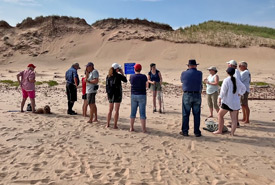The healing power of dunes

Beach walk at St. Peters Lake Run Nature Reserve (Photo by Lanna Campbell/NCC staff)
During the summer of 2023, local community members were invited to attend a beach walk at the Nature Conservancy of Canada's (NCC's) St. Peters Lake Run Nature Reserve on the island's northeastern shore.
Participants were eager to learn about the protective powers of the dunes. The stewardship team informed attendees about the importance of dunes, species that thrive in the coastal environment and best practices when visiting beaches.
After Hurricane Fiona struck PEI in the fall of 2022, many islanders were concerned about the state of the province’s beaches and current condition of the dunes. Although Hurricane Fiona affected many areas on the island, thanks to nature’s healing power, some positive signs were observed during the beach walk as the dunes had already begun the process of reforming and rebuilding themselves.
Intense coastal winds from post-tropical storms and hurricanes are blocked by sand dunes which serve as natural buffers to protect the land and plants behind them. Dunes can rebuild as the sands shift and settle around natural objects like driftwood and vegetation. Slow-growing plants, such as marram grass, also help stabilize the dunes. Marram grass roots grow down and sideways, forming a network that holds the sand in place. Plants above and below the ground bond together to protect and stabilize the iconic dune landscapes of PEI.
Fiona also impacted trees in neighbourhoods, parks and forests across the island, resulting in the loss of nesting sites for birds. However, “it is not always just loss,” says Hannah MacLean, NCC conservation intern in PEI. “It is the beginning of a new landscape that may bring in other animals or support different populations better now.”
The beach walk was a success and the community learned about the dynamic nature of dunes and how they shift over time. This natural evolution occurs even outside of storm season. Participants learned about krummholz, a type of stunted and deformed vegetation or twisted wood that is shaped by exposure to fierce winds. Even though krummholz might look windswept and dead, it is still very much alive and helps strengthen the dunes and coastlines. The group enjoyed learning about krummholz and how nature can help protect itself from harsh elements.
Community events like this one are important, as they help educate the public and relieve the concerns of landowners in the area. Events also help build a long-lasting relationship with the community. Over the coming years, NCC plans to organize marram grass planting events that will help stabilize vulnerable areas along the coast.
Dune education
Here are some tips if you are looking for ways to help protect dunes from further damage:
- Avoid walking on the dunes, and always have your pets on-leash, as their presence can disturb piping plovers that are resting on the beach.
- Plant native species that hold the soil or sand on your property. Species suited for the coast include bayberry, seaside goldenrod and Virginia rose. Species suited for the riverbank include red osier dogwood, chokeberry and willow.
- Please note that any alterations to the dunes, buffer zone and watercourse require a permit.
To learn more about PEI’s dunes, check out the following videos by conservation partners Parks Canada, Island Nature Trust and NCC:




